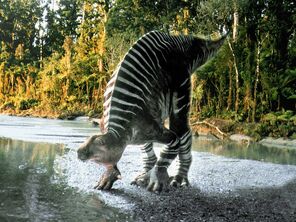| Iguanodon | |
|---|---|
 | |
|
Time |
Early Cretaceous140-112 mya |
|
Diet |
Herbivorous |
|
Range |
Europe and the Americas |
|
Appearances |
Episode 4, Giant of the Skies |
Of all the Dinosaurs that Palaeontologists have discovered, the variants of the genus, Iguanodon, were probably the most successful and widespread ever to have lived. It was an 9-11 metre long Ornithopod Dinosaur, up to 3-4 tonnes in weight. The first Iguanodonts (including Iguanodon) evolved around 140 mya - the last finally becoming extinct 112mya. Though some say earlier, around 125 mya, it is widely held that Iguanodon diversified on a global scale, within a range of habitats; with smaller and larger subspecies which probably had their own regional skin colour patterns. For what was probably over 30 Million Years, Iguanodon, in some form or other, lived on Earth, feeding on the gradually changing vegetation across almost the entire span of the Cretaceous Period.

Iguanodon near a lake. 127 MYA.
Iguanodon has been found in Europe, North America, Asia and has close symonyms in Africa and Australia.
Description[]
Iguanodon has a great history in British Palaeontology. It was the second Dinosaur ever scientifically recognised and named as a form of Dinosaur (under British Palaeontologist Sir Richard Owen's principles); being named in 1825. It was named for its teeth, which broadly resemble Iguana teeth. Iguanodon meaning, Iguana Tooth. It was a very successful dinosaur.

Iguanodon herd on the move, 127 Ma. In 127 Million Years time, their footprints shall be found preserved turned on their side, in California.